Explore Maharashtra’s Rich History and Scenic Landscapes with These Exciting Fort Treks in Maharashtra
For those who love trying new things outdoors, trekking is an excellent activity. Maharashtra is renowned for its multitude of forts, each with its fascinating history. Trekking to these forts in Maharashtra not only satisfies your thirst for adventure but also allows you to learn about their architecture, past, and current state. Moreover, these forts offer breathtaking panoramic views of the surrounding region. If you’re interested, here are some of the finest fort treks in Maharashtra that you can embark on.
1. Rajmachi
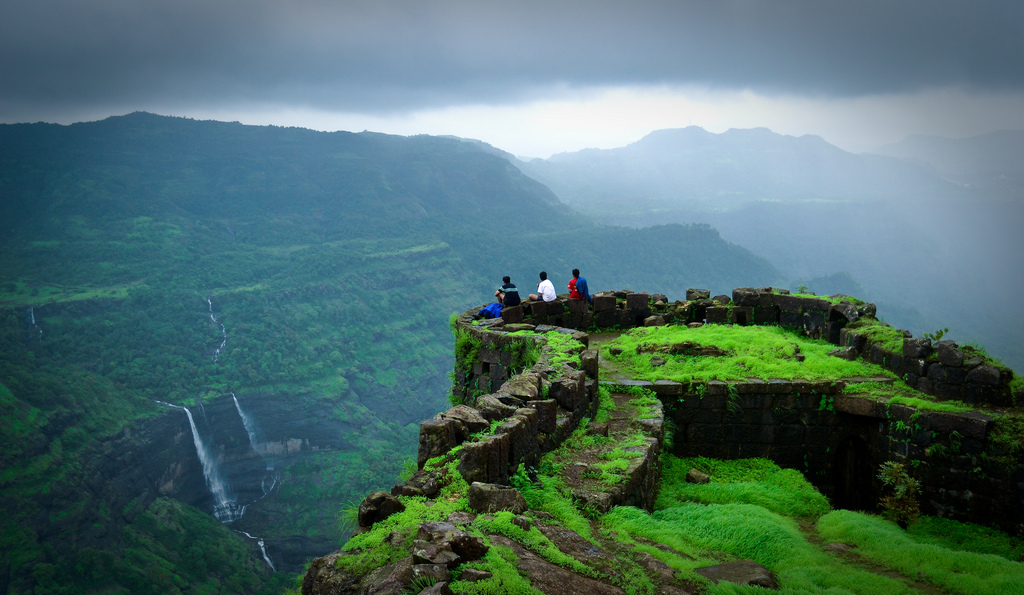
The Rajmachi Fort, located 15 kilometres from the Maharashtra hill stations of Khandala and Lonavala, is a famous tourist site. It is famous for its strategic location as well as historical ruins. The fort is located between two fortified peaks, Shrivardhan and Manaranjan, and is a 30-minute climb from the base village of Udhevadi. Surrounded by a vast plateau, the fort provides a breathtaking view of the Bor Ghat, a vital trade route connecting Mumbai and Pune.
Trek: You have the freedom to choose your trekking route. For beginners, the Lonavala route is recommended, which is a lengthier journey starting from Rajmachi’s base village. This path is surrounded by lush forests, offering an exciting experience. It usually takes around 4 to 5 hours to reach the destination. Alternatively, if you’re seeking an adventurous thrill, the Kondhane route is a great option. The Rajmachi trek via this route is slightly more challenging than the one from Lonavala. It involves a steep ascent of approximately 2.5 to 3 hours to reach the fort.
History of the Fort: The intriguing history of the Rajmachi Fort complex dates back to its construction by the Satavahanas. In 1657, Shivaji Maharaj successfully seized this fort along with neighbouring forts from the Adilshahi ruler of Bijapur. In 1704, the Mughal Emperor Aurangzeb managed to recapture the fort from the Marathas. However, the Marathas reclaimed their dominion the subsequent year, and in 1713, Shahu Maharaj bestowed the Rajmachi fort upon Kanhoji Angre. Following the Marathas’ defeat in 1818, the British assumed control over both the Maratha territories and the Rajmachi Fort.
2. Harishchandragad Trek

Harishchandragad stands as a historic hill fort within Maharashtra’s Ahmednagar district. Positioned merely 8 kilometres away from Khireshwar, 15 kilometres from Malshej Ghat, 50 kilometres from Bhandardara, 166 kilometres from Pune, and 218 kilometres from Mumbai, it holds a notable geographical location. This site carries immense significance as one of Maharashtra’s cherished heritage sites, revered for its historical value. Moreover, it ranks prominently among the favoured fort treks within Maharashtra, often integrated into Malshej Ghat tours.
Trek: Perched at an elevation of 1,424 meters, the fort held a pivotal role in safeguarding and regulating the adjacent region. This stronghold stands as a paramount attraction within Malshej Ghat, well-renowned among tourists. Its origins trace back to the 6th century, under the rule of the Kalchuri dynasty, when construction commenced. During this era, the citadel took shape, and it’s presumed that the intricate caves were hewn out around the 11th century AD. Notably, in the 14th century AD, the revered sage Changdev chose this site for meditation.
Subsequently, the fort transitioned to Mughal control, only to be wrested from them by the Marathas in 1747 AD. The historical relevance of Harishchandragad extends further, with archaeological finds including human remains from the Microlithic period. Its significance is underscored in various ancient texts such as the Matsya Purana, Agni Purana, and Skanda Purana, where the fort finds mention.

History of the Fort: There exist three widely favoured trekking routes that lead to the fort: one through Khireshwar Village, another via Nalichi Vaat, and the third through Paachnai Village.
The route originating from Khireshwar village towards Tolar Khind follows a direct path spanning 2 to 2.5 hours for one-way travel. The starting point, Khireshwar village, is situated approximately 7 kilometres away from Malshej Ghat Bus Stop, in proximity to Khubi Phata Village. Junnar Darwaza, located close to the base village, offers a view of the caves. This trail leads directly to Tolar Khind, where a 100-foot rock section featuring iron railings ensures trekkers’ safety. Beyond this lies a straightforward route to Harishchandreshwar Temple, encompassing minor hills and streams.
An alternative approach to Harischandragad involves Paachnai village, positioned 48 kilometres from Bhandardara. The journey to Harishchandragad spans 5 kilometres from Paachnai and unveils an easy and scenic path amid the forest’s natural allure. Ascending to the summit of Harischandragad typically takes around 3 hours, punctuated by numerous rocky formations and steep inclines.
The third trail, commencing at Belpada village and culminating at Sadhleghat, is tailored for seasoned hikers. This demanding route advances through Sadhleghat, necessitating an ascent up a vertical rock surface aided by handholds. The path remains rocky and uphill beyond this point. The fort itself lies roughly 19 kilometres from Belpada village and entails a 9-hour journey to reach (en route). Camping is permissible at the summit.
3. Kalavantin Fort Trek
Continuing our exploration of the finest fort treks in Maharashtra, the Kalavantin Fort, alternatively referred to as Durg, stands prominently. Positioned in proximity to the Prabalgad Fort along the historic Mumbai-Pune route, it beckons adventure seekers.

Trek: Embarking on this route, you’ll ascend the mountain through a series of rock-cut steps that weave their way up to the fort. These steps, open to the elements, present a vantage point that unveils a panoramic vista of the surroundings. Perched atop the mountain, the fort rests at an altitude of roughly 2,300 feet above sea level. Upon reaching the summit, you’re greeted by lush greenery, and the vista from this point solidifies its reputation as one of the premier fort treks in Maharashtra. However, it’s advisable to avoid trekking to this fort during the monsoon season.
The concluding segment of the Kalavantin Durg trek poses the most formidable challenge. Negotiating steep stairs and scaling a vertical rock surface becomes necessary to conquer the pinnacle, towering at an impressive elevation of 685 meters. Depending on one’s physical fitness, the trek’s duration can span anywhere from 3 to 5 hours to reach completion. The ultimate phase, leading to the pinnacle, amplifies the test inherent in accomplishing this journey.
History of the Fort: Legend attributes the construction of the fort to a queen named Kalavantin. A unique tradition is observed by the Adivasi people of Prabalmachi village, who partake in dancing festivities atop the Kalavantin fort during the Holi (Shimga) Festival. In the early 19th century, Umaji Naik, a notable freedom fighter, utilized the fort as a clandestine sanctuary.
The history of Kalavantin Durg often intertwines with that of its neighbouring Prabalgad Fort. Constructed approximately in 530 BC, the latter stands as a towering stone spire soaring to a height of 685 meters (2,300 feet), a marvel of the Bahmani Sultanate’s era. The Ahmadnagar Sultanate assumed control of the fort in 1458 AD, marking a turning point. Subsequently, it fell under the dominion of the Mughal Empire, becoming the arena for several confrontations among diverse dynasties as the centuries unfurled.
4. Korigad Fort Trek
Korigad stands as a prominent hill fort in Maharashtra, nestled within the Pune district. Its elevation reaches approximately 2800 feet above the surrounding terrain. While numerous of its fortifications have diminished, the fort’s encompassing wall remains remarkably preserved. A two-kilometre-long circumambulation is feasible around the perimeter of the fortress. Within its confines, one discovers the presence of caves and water cisterns, contributing to the fort’s historical significance.
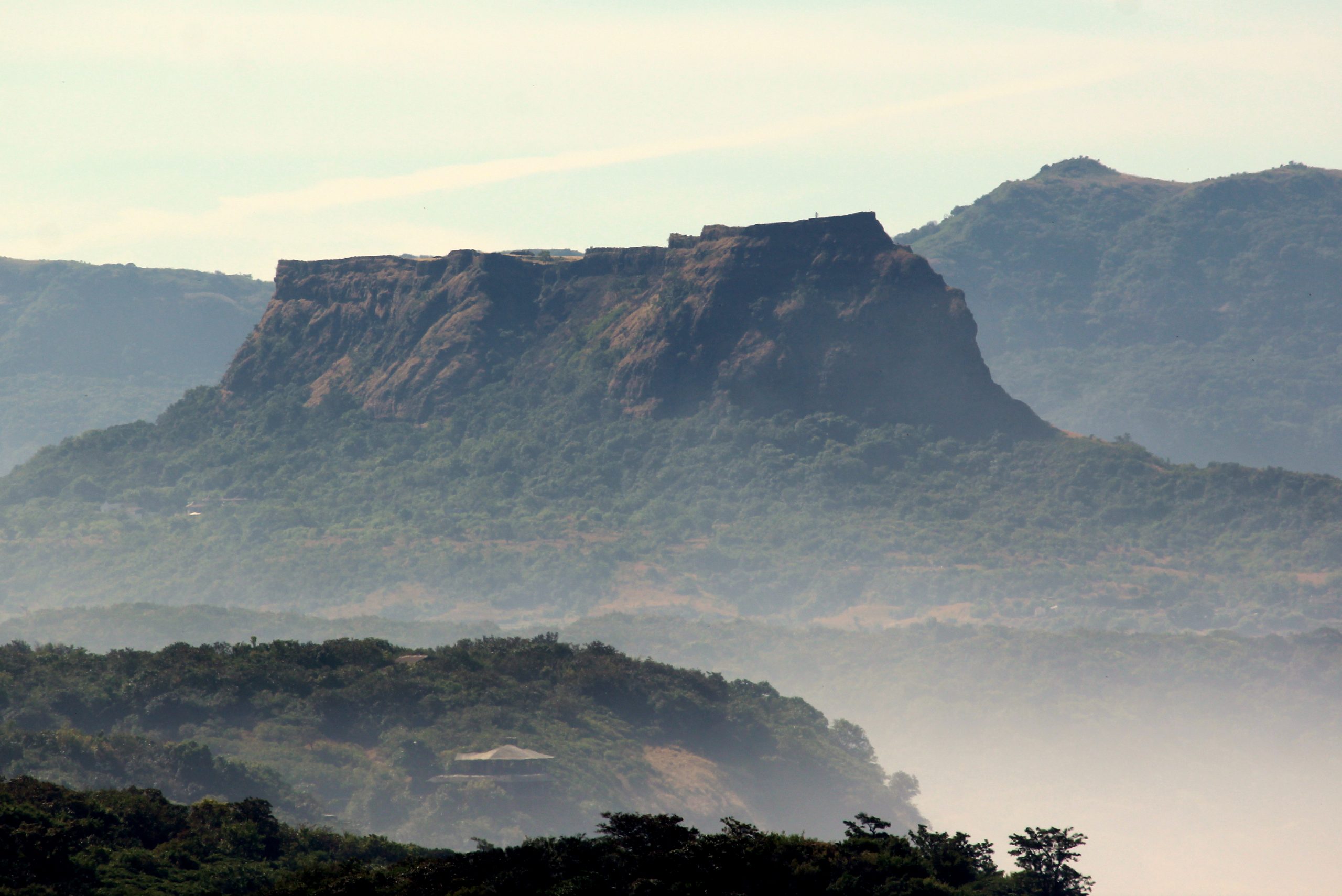
Trek: The trekking path leading to Korigad Fort is characterized by its simplicity and clear markings, rendering it one of the most effortless fort treks within Maharashtra. The journey to the summit initiates from either a temple or a small forested area. Remarkably, ascending to the top of Korigad Fort consumes a mere 45 minutes. Renowned as a favoured one-day trek in the vicinities of Mumbai, Thane, and Pune, the Korigad Fort Trek holds popularity.
Optimally, the monsoon season provides the best backdrop for a visit to Korigad Fort. With its ease of access and gentle incline, Korigad Fort Trek emerges as an ideal choice, especially for newcomers and those venturing into trekking for the first time.
History of the Fort: Situated to the southern periphery of Lonavala, the Korigad Fort, alternately known as Koraigad or Koarigad, graces the landscape. This fort holds an estimated age of around 1500 years. In the year 1657, Chhatrapati Shivaji Maharaj asserted his authority by capturing the neighbouring forts of Lohagad, Visapur, Tung, and Tikona. However, on the 14th of March, 1818, the British wrested control of this fort from the Marathas.
The southern and eastern flanks of the fort now provide a foundation for Aamby Valley, a meticulously planned city. During the monsoon season, a captivating sight unfolds as water gracefully descends historical staircases. Koraigad Fort is enveloped by the scenic Lonavala Mountain Range, offering a sweeping view of Tung Fort, Pawna Lake, and the urban expanse of Aamby Valley City.
5. Lohagad Fort Trek

Positioned amidst the Sahyadri hills within the Lonavala vicinity of Maharashtra, the Lohagad Fort, also known as the Iron Fort, stands as a testament to history. It resides approximately 11 kilometres away from Lonavala, 66 kilometres from Pune, and 114 kilometres from Mumbai. This site holds esteemed stature as a renowned heritage destination within Maharashtra acclaimed as one of the premier fort treks catering to tourists’ interests.
Trek: The most expedient and straightforward approach involves driving to Lohagadwadi’s foundational village and subsequently ascending the fort via its stone steps. An alternative route originates from Bhaje, a settlement situated around 5 to 6 kilometres from Malavali. The path to Gaumukh Khand unfolds as one embarks on a journey from Bhaje village. At this juncture, a pivotal decision must be made. By making a right turn, progress towards Lohagad Fort is ensured; however, a left turn would lead to the fort of Visapur. With this determination, the journey advances further, with a left turn guiding the way towards the fort’s stairwell, a significant milestone to be reached.
History of the Fort: The Lohagarh Fort holds a unique place in history. The term ‘Lohagad’ translates to ‘fort of iron,’ and this fort lives up to its name, boasting almost impenetrable defences. It is encircled by profound moats, giving rise to a widespread belief that the fort’s fall was only possible “when a crocodile swallowed all the water in the moat.” Originating in the 1730s, the fort now primarily serves as a hub for government offices and hosts a museum, marking a shift from its earlier purpose.
6. Ratangad Fort Trek
Ratangad, an age-old hill fort, finds its abode in the village of Ratanwadi within Maharashtra’s Ahmednagar district. Positioned 6 kilometres away from Ratanwadi, 23 kilometres from Bhandardara, 183 kilometres from Pune, and 197 kilometres from Mumbai, it emerges as a prominent landmark. Notably, Ratangad stands among Maharashtra’s finest fort treks, extending a splendid opportunity for exploration in close proximity to Mumbai and Pune.
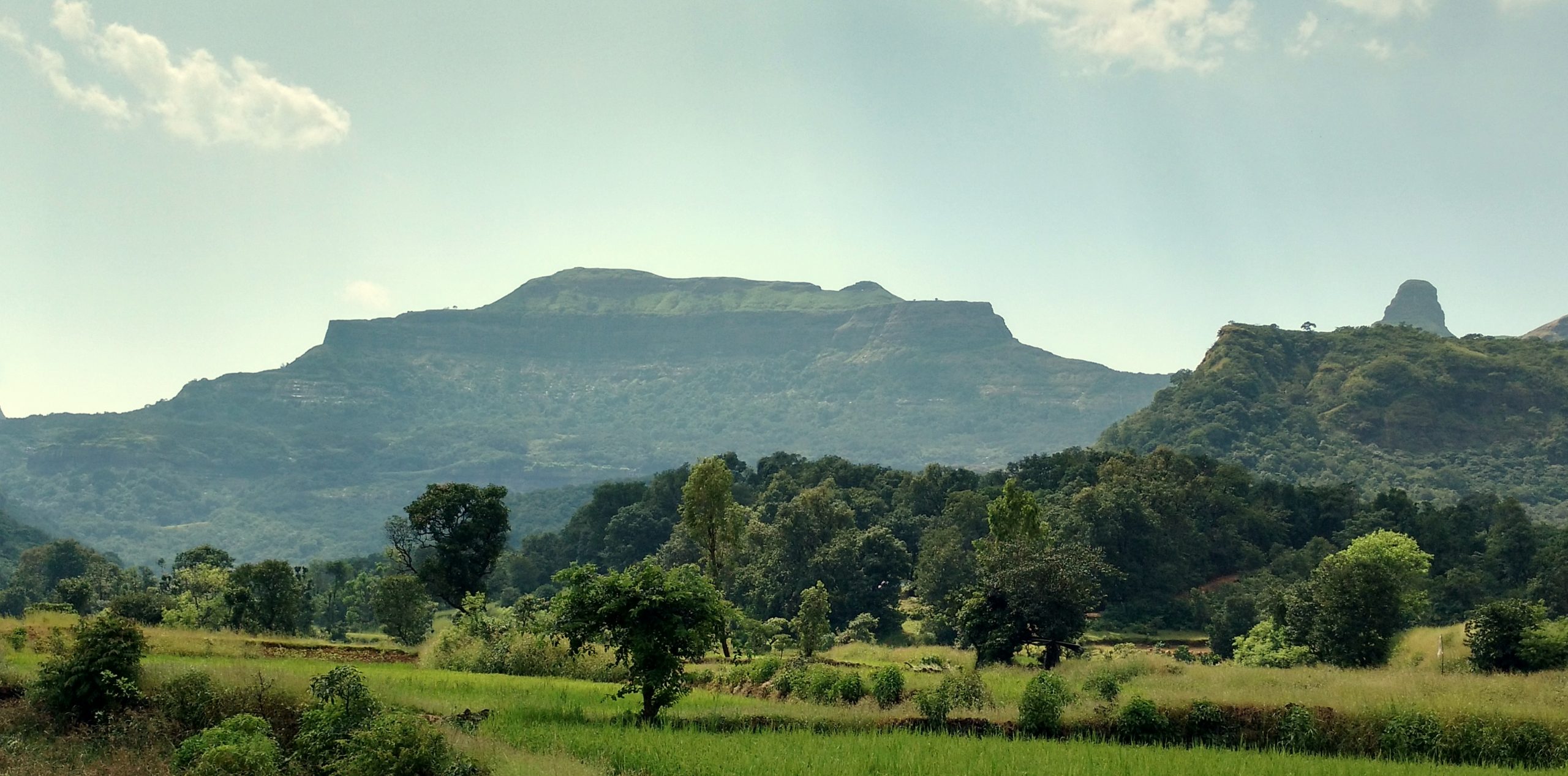
Trek: Commencing the trek, you’ll encounter a terrain characterized by a notably steep ascent, serving as a rigorous trial of your endurance. The path’s uneven nature might lead to route confusion, especially during foggy conditions. As a precaution, it’s advisable to engage a guide, ensuring a secure and efficient climb to the fort. While the forested segment presents challenges, respite arrives with two plateaus that punctuate the journey, offering a welcome interlude. Conquering the final stretch becomes more manageable with the aid of ladders, culminating at the Tryambak Darwaja, the designated entrance to the fort.
History of the Fort: Ratangad, a fort with a rich history dating back 400 years, became a conquest under the reign of Chatrapati Shivaji Maharaj. Situated in its base village of Ratanwadi, Ratangad commands a vantage point overlooking the scenic expanse of Bhandardara.
7. Irshalgad Fort Trek
Perched at an altitude of 3700 feet above sea level, Irshalgad Fort stands as the sibling counterpart to Prabalgad Fort. Constructed during the Bahmani Sultanate era, this site boasts a remarkable history. Nestled within a dense forested environment, Irshalgad presents an array of exhilarating hiking trails, inviting adventure seekers. Notably, the pinnacle of Irshalgad serves as an excellent venue for mountaineering enthusiasts. The pinnacle offers a rewarding experience with a panoramic spectacle of the Western Ghats, rendering the journey to the top undeniably worthwhile.
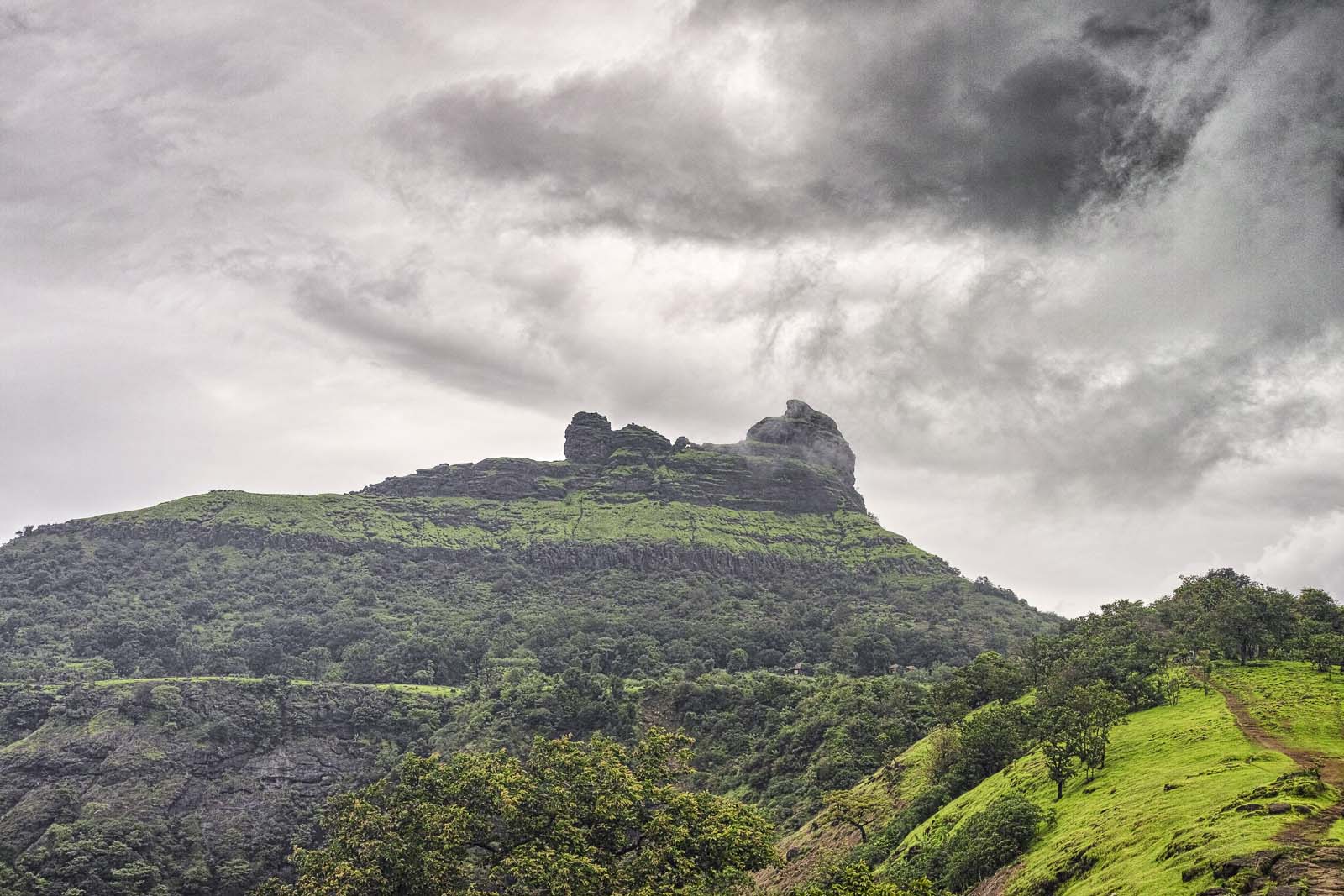
Trek: The closest railway station to Irshalgad is Karjat. From Karjat, you would need to arrange for a taxi to transport you to Irshalwadi village. Alternatively, if you’re travelling by road, you can drive to Chowk/Chauk village in your private vehicle. From there, the journey to the fort takes around an hour.
The ascent to the fort typically spans about 2 hours, while the descent requires around 1.5 hours. It’s advisable to plan your trek between the months of August and March, as this timeframe avoids the extreme heat of summer and the heavy rains of the monsoon season, ensuring a more comfortable and enjoyable experience.
History of the Fort: The name Irshalgad might be deceptive, as it signifies a pinnacle rather than a conventional fort, a rarity in historical nomenclature. This characteristic holds significance throughout history. It’s plausible that Irshalgad functioned as a watchtower, surveilling the region between Manikgad and Prabalgad. During the tenure of Shivaji Maharaj’s reign, wherein he annexed Kalyan, Bhiwandi, and extended to Rairi in May 1666, Irshalgad was likely under Maratha control. The fort shares a border with Prabalgad.
A tragic incident occurred on January 23, 1972, when Kumar Prakash Durve lost his life due to a fall from this vantage point. To commemorate this event, trekkers from the Mumbai-Thane region gather at Irshalgad every year on January 26th, honouring the day.
8. Harihar Fort Trek
Harihar Fort, also known as Harihargad, stands as a modest hill fort within the Upper Vaitarana range in the Nashik district of Maharashtra. Situated approximately 22 kilometres away from Trimbakeshwar and 45 kilometres from Nashik, it assumes a notable position. The fort, which is alternately referred to as Harshgad or Harishgad, holds the distinction as a sought-after destination for monsoon treks, typifying Maharashtra’s allure for such endeavours.
Trek: Perched at an elevation of 1120 meters (3676 feet), Harihargad occupies a distinctive triangular rock formation, characterized by three vertical sides. Access to the fort is limited to one side only, achieved through a 200-foot-high rock-cut staircase. The most captivating element of this trek is the set of rock-cut steps, positioned at an impressive 80-degree incline. These steps, despite their vertical arrangement, are equipped with recesses that offer a secure grip during the ascent. In total, there are 117 steps, and negotiating this segment proves to be a thrilling adventure, both while ascending and descending.

The gateway to the fort, known as the Darwaja, becomes accessible after ascending the initial set of stairs. Subsequently, a very narrow path follows, necessitating careful navigation. To reach the fort’s summit, an ascent of 100 steep stairs is once again required. The fort’s distinguishing features include a tapering plateau with a central elevated section. Nestled on this plateau, a modest temple is dedicated to Lord Hanuman and Lord Shiva. Adjacent to the temple, a small pond provides potable water.
Within the fort, a diminutive palace comprises two rooms. Running along one side of the palace, a collection of five cisterns is present, one of which holds drinkable water.
The journey to Harihar Fort commences at Nirgudpada, situated around 22 kilometres from Trimbakeshwar. From this base village, visitors undertake a 4-kilometre trek to reach Harihar Fort. The ascent to the fort’s summit is characterized as moderate and consumes approximately 2 hours.
History of the Fort: During the rule of the Ahmadnagar Sultans, they possessed a collection of forts, one of which was Harish Fort. In 1818 AD, Captain Briggs conducted a visit to this fort. In 1636 CE, Shahaji handed over several forts, including Harishgad, Trimbakgad, Tringalwadi, and a handful of others, to the Mughals. When Trimbak fell in 1818 CE, Harishgad was among the 17 strongholds that submitted to British authority.
9. Tikona Fort Trek
Tikona Fort also referred to as the Triangle Fort, commands a significant presence as a prominent hill fort within the Maval region of Lonavala, Maharashtra. Positioned at a distance of 21 kilometres from Lohagad Fort, 25 kilometres from Lonavala, 53 kilometres from Pune, 135 kilometres from Mumbai, and 22 kilometres from Tung Fort, this fort stands as a beacon. It ranks among the premier fort treks in Maharashtra, drawing travellers from Pune and Mumbai for a memorable day excursion.
Known by its alternate name, Vitandgad Fort, Tikona Fort graces an elevation of 3633 feet above sea level, securing its place as a remarkable landmark within the landscape.

Trek: The Tikona Fort trek commences from the village of Tikona Peth, located in close proximity to the fort. A motorable road extends from Tikona Peth village to the fort’s base, covering a distance of 2 kilometres. The actual trek spans 1 to 1.5 hours from the fort’s base and is classified as moderately challenging. En route, a cave makes an appearance, followed by a statue of Lord Hanuman. The entrance to the bastion is accessed via a path adjacent to the cave. Here, the ascent involves tackling around 100 steep stairs. The staircase is divided into two segments, with a fixed rope equipped with bolts serving as a means of support while ascending.
History of the Fort: In contrast to numerous other forts in the region, the history of this formidable Tikona Fort remains shrouded in obscurity. In 1585 AD, the Nizam Shahi dynasty achieved the conquest of the fort, thus incorporating it into the Nizam’s dominion. Later, in 1657 AD, Shivaji Maharaj executed the capture of Tikona, alongside Karnala, Lohagad, Mahuli, Songad, Tala, and Visapur forts, effectively bringing the entire Konkan area, hitherto under Nizam’s rule, under his domain.
The historical trajectory continued as the Tikona Fort changed hands. As part of the Treaty of Purandar, signed on June 12, 1665, the fort was relinquished to the Mughals. However, in 1670 AD, Shivaji Maharaj reclaimed the fort, highlighting the ebb and flow of control during this era.
10. Raigad Fort Trek
Perched gracefully upon the Sahyadri mountain range in Mahad, Maharashtra, the captivating Raigad Fort rises to an elevation of approximately 820 meters. With deep valleys encircling three sides, this majestic stronghold finds accessibility only from a single direction, facilitated by a 1737-step pathway. This fort stands as a symbol of immense pride for the Marathas, a testament to their courage and determination.
Beyond being a mere tourist attraction, the Raigad Fort holds sacred significance, embodying a pilgrimage destination that resonates with the legacy of Chhatrapati Shivaji’s visionary pursuit of Hindavi Swarajya. Although much of its infrastructure now lies in ruins, the fort remains a living testament to the valiant history of the Maratha Empire, serving as a tangible link to their heroic past.
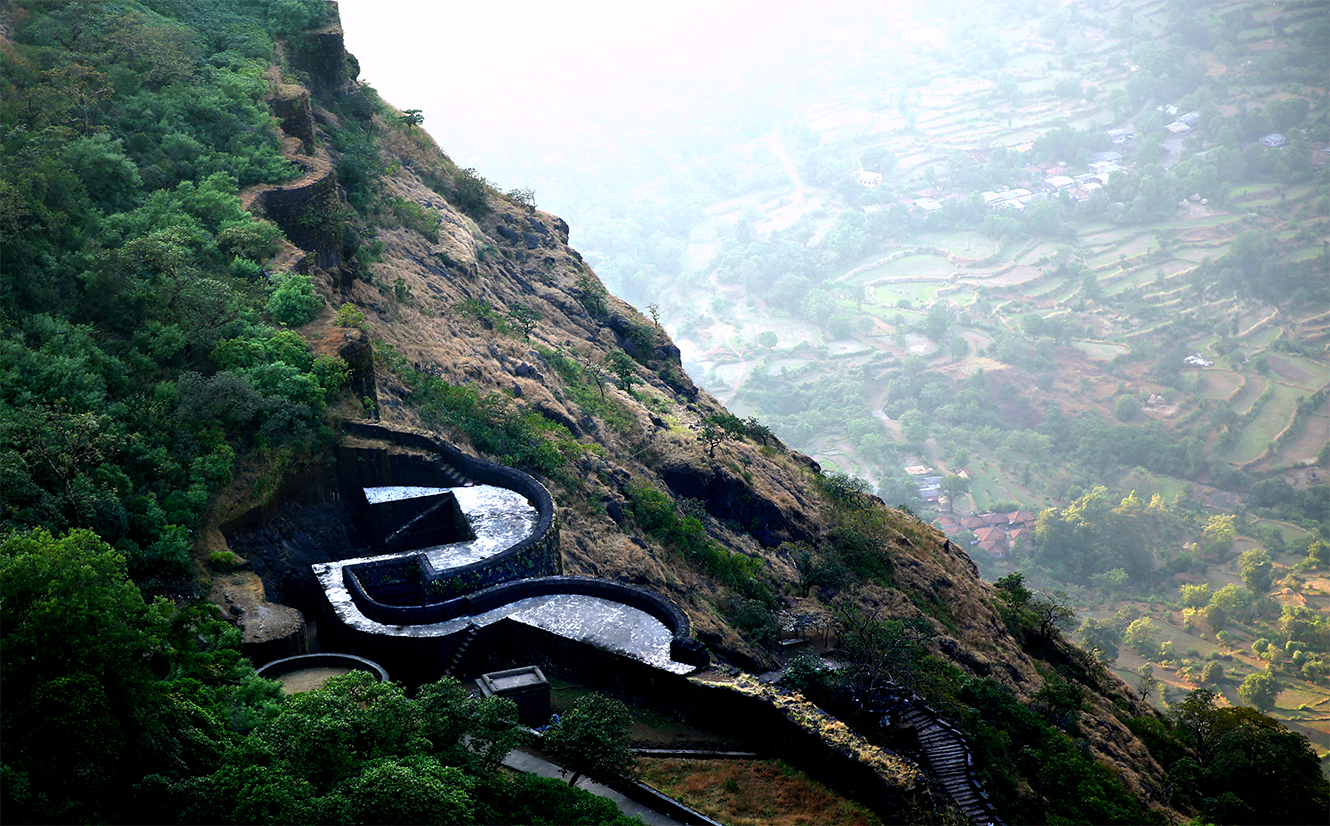
Trek: For those with an affinity for trekking, two options are available: ascending the 1737 steps or taking the bus to Pachad. The journey to the fort entails navigating these steps. However, an alternative route exists in the form of the Raigad Ropeway, an aerial tramway that reduces the travel time to a mere 4 minutes. This ropeway serves as a convenient solution for those who do not relish trekking. Stretching across a diagonal length of 760 meters and boasting a steep ascent of 420 meters, the ropeway offers a swift and scenic passage to the pinnacle.
As the ropeway ascends, enveloped by the serenade of whistling winds and surrounded by lush greenery, the experience becomes truly enchanting. The ropeway fare not only grants access to the fort but also includes additional benefits. Visitors can explore the museum and enjoy a film show as part of the package, enhancing the overall experience of their Raigad Fort visit.
History of the Fort:
Chandrarao Mores undertook the construction of this grand fort in the year 1030. Subsequently, Chhatrapati Shivaji Maharaj claimed the fort of Rairi from the Chandrarao Mores royal lineage, which hailed from the ancient Maurya Dynasty, in 1656. A significant transformation occurred as Shivaji Maharaj refurbished and expanded the fort, bestowing upon it the new name of Raigad, which translates to “King’s Fort.” This remarkable fortress was also designated as the capital of the Maratha kingdom.
In the wake of capturing the Raigad Fort, Shivaji Maharaj undertook the establishment of Fort Lingana in its proximity. The fort drew the attention of a military endeavour orchestrated by the British East India Company in 1765. Ultimately, on May 9, 1818, the fort transitioned into British dominion, marking a pivotal shift in its history.
As the trails wind through Maharashtra’s historic forts, each step is a journey back in time, echoing the stories of valiant conquerors, architectural marvels, and breathtaking landscapes. Whether you’re drawn to the rugged beauty of Rajmachi, the mystique of Harishchandragad, or the commanding presence of Raigad, the forts of Maharashtra offer a captivating tapestry of heritage and adventure.
Embark on these treks, where history whispers through weathered stones, and nature’s splendour unfolds at every turn. So, lace up your hiking boots, embrace the thrill of the ascent, and let the forts of Maharashtra unveil their secrets, one step at a time.
Write with us✍?
TeamUgtWorld warmly welcomes everyone! If you have something on your mind that you’d like to write about, we invite you to publish your content on our platform @Ugtworld. To learn more, please click on the link provided below.


